Hi guys
Merry Christmas
Did you know that Christmas Day is not a holiday in Iran?
And people have to go to work!
including myself😅
Next, I put the google translation of one of the articles prepared on one of the travel and advertising sites.
It has provided good information about celebrating Christmas in Iran. (The source of this article is this site.)
Like Christians all over the world, Armenians and Assyrians of Iran also prepare themselves for the arrival of the New Year in the last days of December and celebrate Christmas by organizing special ceremonies.
According to the ancient tradition, Christians consider the beginning of the year to be January 1st, just as Iranians consider the beginning of their year to be Farvardin (March 21st), and Arabs consider the beginning of their year to be Muharram. In the 17th century, when December 25th was declared holy, this day was known as Christmas or the birth of Jesus Christ, and almost all followers of the Christian religion celebrate this day as the birth of Jesus Christ.
Christians in Iran, where more than 97% of the population are Muslims, are considered religious minorities. Iranian Christians are divided into two groups, Armenians and Assyrians, whose Christmas rituals are different.
The Assyrians were the tribes that lived in the land of ancient Iran and converted to this religion from the beginning of Christianity, especially in the first to third centuries AD. Like most Christians in the world, they consider December 25 as the birthday of Jesus Christ and celebrate it.
From 25 days before the birth of Christ, Assyrian Christians observe a fasting called fasting and during this period they avoid eating meat and dairy products. After the arrival of December 25, the Assyrians finish their fast and attend the church and celebrate the Eucharist.
They gathered in the church and performed the special ritual of the birthday of Jesus Christ by saying the prayer and performing the Mass by the bishop, and they visit under the same pretext. Assyrian customs are such that on the fourth day of December (December 25), people go to churches to see and congratulate the Assyrian clerics, and the next day, it is the clerics who go to see and visit their co-religionists. Another noteworthy point is that unlike all Christians who consider January 1st as the beginning of the new year, the Assyrian New Year is in the month of Nisan and coincides with the 1th of April ceremony of Iranians.
If you are a curious person, you know that Armenian Christmas is a little later than their foreign counterparts; It starts about ten days later. That is, while most of the world's Christians (from Catholics and Protestants to a major group of Orthodox) consider December 25 as the birthday of Jesus Christ (PBUH), the followers of the Armenian Independent Church consider January 6 as Christmas. Despite this difference, the Christian New Year begins on the night of January 1 and is accompanied by its own special ceremony.
Decorated trees along with images of Maryam, Yusuf and baby Jesus can also be seen in the shops of Mirzai Shirazi and Nejatullahi Streets in Tehran where many Armenians of Iran live in those areas. Some Iranian Christians celebrate the 25th of December and the 1st of January as the New Year. Unlike some Islamic countries where Christian celebrations are limited to hotels where foreigners stay, there are no such restrictions in Tehran.
Behind the glass of most of the shops, leaflets are pasted, which announce the time and place of the celebration and their live music performance, along with the color photos of some young Armenians. The best programs should be found in "Ararat" club; There, in addition to setting up a charity bazaar, the best Armenian music groups have a program. Two or three nights of performances in the indoor hall of the club, which is, of course, an elaborate celebration and not limited to music alone. In addition, these programs also have an expensive entrance fee that increases every year.
On the first night of January, church bells ring to mark the beginning of the new year; Right at 12 o'clock, at the same time as the start of Nowruz, Armenian families enter the church yard in groups.
On the night of January 5, a very grand ceremony is held in the churches. Armenians have two main festivals, Christmas and Easter, which is celebrated in the evening. Apart from this ceremony, Badarak is held in the morning. People go to church and open their fast with Holy Communion, and as a blessing, they give everyone blessed butter, which they put on their food. There is also a water blessing ceremony, which commemorates Christ's baptism in the Jordan River, a cross is placed in a large container of water and blessed with holy oil, and then a teenager pulls out the cross and distributes the blessed water to the people, who also use it for They take it to bless the house and to heal the sick.
The New Year ceremony is held every year at midnight on the 1st of January in the biggest and most beautiful church in Iran, Vank Church, located in the Armenian neighborhood of Jolfa, Isfahan.
I have summarized the article a little, I hope you have more information about Christmas in Iran.
Merry Christmas to you.



Copying/Pasting content (full or partial texts, video links, art, etc.) with adding very little original content is frowned upon by the community. Publishing such content could be considered exploitation of the "Hive Reward Pool" and may result in the account being Blacklisted.
Please refrain from copying and pasting, or decline the rewards on those posts going forward.
If you believe this comment is in error, please contact us in #appeals in Discord.